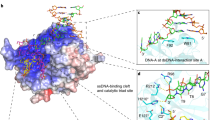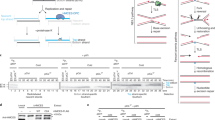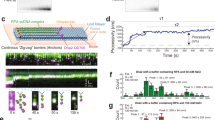Abstract
Abasic (AP) sites are one of the most common DNA lesions that block replicative polymerases. 5-hydroxymethylcytosine binding, embryonic stem cell-specific protein (HMCES) recognizes and processes these lesions in the context of single-stranded DNA (ssDNA). A HMCES DNA-protein cross-link (DPC) intermediate is thought to shield the AP site from endonucleases and error-prone polymerases. The highly evolutionarily conserved SOS-response associated peptidase (SRAP) domain of HMCES and its Escherichia coli ortholog YedK mediate lesion recognition. Here we uncover the basis of AP site protection by SRAP domains from a crystal structure of the YedK DPC. YedK forms a stable thiazolidine linkage between a ring-opened AP site and the α-amino and sulfhydryl substituents of its amino-terminal cysteine residue. The thiazolidine linkage explains the remarkable stability of the HMCES DPC, its resistance to strand cleavage and the proteolysis requirement for resolution. Furthermore, its structure reveals that HMCES has specificity for AP sites in ssDNA at junctions found when replicative polymerases encounter the AP lesion.
This is a preview of subscription content, access via your institution
Access options
Access Nature and 54 other Nature Portfolio journals
Get Nature+, our best-value online-access subscription
$29.99 / 30 days
cancel any time
Subscribe to this journal
Receive 12 print issues and online access
$189.00 per year
only $15.75 per issue
Buy this article
- Purchase on Springer Link
- Instant access to full article PDF
Prices may be subject to local taxes which are calculated during checkout




Similar content being viewed by others
Data availability
References
Krokan, H. E. & Bjoras, M. Base excision repair. Cold Spring Harb. Perspect. Biol. 5, a012583 (2013).
Hitomi, K., Iwai, S. & Tainer, J. A. The intricate structural chemistry of base excision repair machinery: implications for DNA damage recognition, removal, and repair. DNA Repair (Amst.) 6, 410–428 (2007).
Tsutakawa, S. E., Lafrance-Vanasse, J. & Tainer, J. A. The cutting edges in DNA repair, licensing, and fidelity: DNA and RNA repair nucleases sculpt DNA to measure twice, cut once. DNA Repair (Amst.) 19, 95–107 (2014).
Kavli, B. et al. Excision of cytosine and thymine from DNA by mutants of human uracil-DNA glycosylase. EMBO J. 15, 3442–3447 (1996).
Schaaper, R. M., Kunkel, T. A. & Loeb, L. A. Infidelity of DNA synthesis associated with bypass of apurinic sites. Proc. Natl Acad. Sci. USA 80, 487–491 (1983).
Mohni, K. N. et al. HMCES maintains genome integrity by shielding abasic sites in single-strand DNA. Cell 176, 144–153 e13 (2019).
Aravind, L., Anand, S. & Iyer, L. M. Novel autoproteolytic and DNA-damage sensing components in the bacterial SOS response and oxidized methylcytosine-induced eukaryotic DNA demethylation systems. Biol. Direct 8, 20 (2013).
Kallen, R. G. Mechanism of reactions involving Schiff base intermediates. Thiazolidine formation from l-cysteine and formaldehyde. J. Am. Chem. Soc. 93, 6236–6248 (1971).
Canle, M., Lawley, A., McManus, E. C. & O’Ferrall, R. A. M. Rate and equilibrium constants for oxazolidine and thiazolidine ring-opening reactions. Pure Appl. Chem. 68, 813 (1996).
Just, G., Chung, B. Y., Kim, S., Rosebery, G. & Rossy, P. Reactions of oxygen and sulphur anions with oxazolidine and thiazolidine derivatives of 2-mesyloxymethylglyceraldehyde acetonide. Can. J. Chem. 54, 2089–2093 (1976).
Ratner, S. & Clarke, H. T. The action of formaldehyde upon cysteine. J. Am. Chem. Soc. 59, 200–206 (1937).
Fife, T. H., Natarajan, R., Shen, C. C. & Bembi, R. Mechanism of thiazolidine hydrolysis. Ring opening and hydrolysis of 1,3-thiazolidine derivatives of p-(dimethylamino)cinnamaldehyde. J. Am. Chem. Soc. 113, 3071–3079 (1991).
Brooks, S. C., Adhikary, S., Rubinson, E. H. & Eichman, B. F. Recent advances in the structural mechanisms of DNA glycosylases. Biochimica Biophys. Acta Proteins Proteom. 1834, 247–271 (2013).
Fromme, J. C. & Verdine, G. L. Base excision repair. Adv. Protein Chem. 69, 1–41 (2004).
Beard, W. A. & Wilson, S. H. Structure and mechanism of DNA polymerase β. Chem. Rev. 106, 361–382 (2006).
Billman, J. H. & Diesing, A. C. Reduction of Schiff bases with sodium borohydride. J. Org. Chem. 22, 1068–1070 (1957).
Kweon, S. M. et al. Erasure of Tet-oxidized 5-methylcytosine by a SRAP nuclease. Cell Rep. 21, 482–494 (2017).
Prasad, R., Horton, J. K., Dai, D. P. & Wilson, S. H. Repair pathway for PARP-1 DNA-protein crosslinks. DNA Repair (Amst.) 73, 71–77 (2019).
Prasad, R. et al. Suicidal cross-linking of PARP-1 to AP site intermediates in cells undergoing base excision repair. Nucleic Acids Res. 42, 6337–6351 (2014).
Sczepanski, J. T., Wong, R. S., McKnight, J. N., Bowman, G. D. & Greenberg, M. M. Rapid DNA-protein cross-linking and strand scission by an abasic site in a nucleosome core particle. Proc. Natl Acad. Sci. USA 107, 22475–22480 (2010).
Grosheva, A. S. et al. Recognition but no repair of abasic site in single-stranded DNA by human ribosomal uS3 protein residing within intact 40S subunit. Nucleic Acids Res. 45, 3833–3843 (2017).
Spruijt, C. G. et al. Dynamic readers for 5-(hydroxy)methylcytosine and its oxidized derivatives. Cell 152, 1146–1159 (2013).
Krokan, H. E. et al. Error-free versus mutagenic processing of genomic uracil–relevance to cancer. DNA Repair (Amst.) 19, 38–47 (2014).
Otwinowski, Z. & Minor, W. Processing of X-ray diffraction data collected in oscillation mode. Methods Enzymol. 276, 307–326 (1997).
Adams, P. D. et al. PHENIX: a comprehensive Python-based system for macromolecular structure solution. Acta Crystallogr. D 66, 213–221 (2010).
Emsley, P. & Cowtan, K. Coot: model-building tools for molecular graphics. Acta Crystallogr. D 60, 2126–2132 (2004).
Morin, A. et al. Collaboration gets the most out of software. eLife 2, e01456 (2013).
Ashkenazy, H. et al. ConSurf 2016: an improved methodology to estimate and visualize evolutionary conservation in macromolecules. Nucleic Acids Res. 44, W344–W350 (2016).
Acknowledgements
This work was supported by NIH grants nos. R01ES030575 (D.C.), R01GM117299 (B.F.E.) and P01CA092584 (D.C. and B.F.E.). P.S.T. was supported by F30CA228242, K.M.A. was supported by the Vanderbilt Molecular Biophysics Training Program (T32GM08320) and K.N.M. was supported by T32CA009582. Core facilities were supported by the Vanderbilt-Ingram Cancer Center P30CA068485. Use of the Advanced Photon Source was supported by the US Department of Energy, Office of Science, Office of Basic Energy Sciences, under Contract No. DE-AC02-06CH11357. Use of LS-CAT Sector 21 beamline was supported by the Michigan Economic Development Corporation and the Michigan Technology Tri-Corridor (grant 085P1000817).
Author information
Authors and Affiliations
Contributions
P.S.T., K.M.A. and K.N.M designed and completed the experiments, interpreted results and edited the manuscript. D.C. and B.F.E. supervised and funded the project, designed experiments and wrote the manuscript.
Corresponding authors
Ethics declarations
Competing interests
The authors declare no competing interests.
Additional information
Peer review information: Beth Moorefield was the primary editor on this article and managed its editorial process and peer review in collaboration with the rest of the editorial team.
Publisher’s note: Springer Nature remains neutral with regard to jurisdictional claims in published maps and institutional affiliations.
Integrated supplementary information
Supplementary Figure 1 SRAP conservation.
a. Structure-based sequence alignment between E. coli YedK and human HMCES SRAP domain, together with a sequence alignment of SRAP domains from 8 additional species. Secondary structure from the YedK DPC structure is shown above the alignment. Symbols above specific residues denote those involved in binding DNA (circles), distorting DNA at the 5′ side of the AP site (wedge, blue circles), stacking against dsDNA immediately 3′ to the AP site (shelf, magenta circles), and stabilizing the thiazolidine crosslink (Cys2 pocket, “×”). b. Orthogonal views of the YedK DPC structure colored rainbow from N- (blue) to C-terminus (red). c. Superposition of E. coli YedK DPC (blue/gold) and human HMCES SRAP domain (PDB ID 5KO9, silver). The r.m.s.d. between the structures is 1.40 Å for all backbone atoms. d. Superposition of YedK DPC (blue/magenta) and free YedK (orange). Loops in YedK DPC that are disordered in the free protein are colored magenta. Proteins are shows as a Cα-backbone trace.
Supplementary Figure 2 Details of the SRAP active site.
Stereo views of residues contacting the thiazolidine linkage in the two protein-DNA complexes in the asymmetric unit of the YedK DPC structure, superimposed with 1σ 2Fo-Fc electron density. Dashed lines and numbers indicate lengths of hydrogen bonds in Å.
Supplementary Figure 3 Structural details of the non-covalent SRAP-DNA complex.
a. Superposition of YedK covalently crosslinked to AP-DNA (blue) and non-covalently bound to C3-spacer DNA (magenta). The abasic site is marked with an asterisk. The double-headed arrow shows the most significant difference between the two structures—movement of β-hairpin (β7- β8) that stabilizes the backbone of the DNA 3′ to the AP site. b. Stereo view of the YedK active site in the YedK/C3-spacer-DNA structure, superimposed with 1σ 2Fo-Fc electron density. The C3-spacer is colored green and flanking nucleotides gold. Dashed lines and numbers indicate lengths of hydrogen bonds in Å. c. DNA in the DPC (top) and non-covalent C3-spacer (bottom) structures, colored by B-factor. d. Average B-factor of each nucleotide in the DPC (black) and non-covalent C3-spacer (blue) structures.
Supplementary Figure 4 Binding of HMCES SRAP domain to ssDNA and ssDNA/dsDNA junctions containing a tetrahydrofuran (THF) abasic site analog.
Binding was monitored by a change in fluorescence anisotropy as protein was titrated against DNAs that contained a FAM label at the 5′-end of the THF strand. The maximal change in anisotropy (amplitude of binding isotherm at saturation) is dependent on the tumbling rate of the FAM label, which is different for each of the three substrate. Dissociation constants (Kd) were derived from non-linear least squares fit of a two-state, single-site binding model to the data.
Supplementary information
Supplementary Information
Supplementary Figs. 1-4, Supplementary Table 1, Supplementary Dataset 1
Rights and permissions
About this article
Cite this article
Thompson, P.S., Amidon, K.M., Mohni, K.N. et al. Protection of abasic sites during DNA replication by a stable thiazolidine protein-DNA cross-link. Nat Struct Mol Biol 26, 613–618 (2019). https://doi.org/10.1038/s41594-019-0255-5
Received:
Accepted:
Published:
Issue Date:
DOI: https://doi.org/10.1038/s41594-019-0255-5
This article is cited by
-
Bacterial DNA excision repair pathways
Nature Reviews Microbiology (2022)
-
HMCES safeguards genome integrity and long-term self-renewal of hematopoietic stem cells during stress responses
Leukemia (2022)
-
The HMCES DNA-protein cross-link functions as an intermediate in DNA interstrand cross-link repair
Nature Structural & Molecular Biology (2022)
-
Crosslink and shield: protecting abasic sites from error-prone repair
Nature Structural & Molecular Biology (2019)



